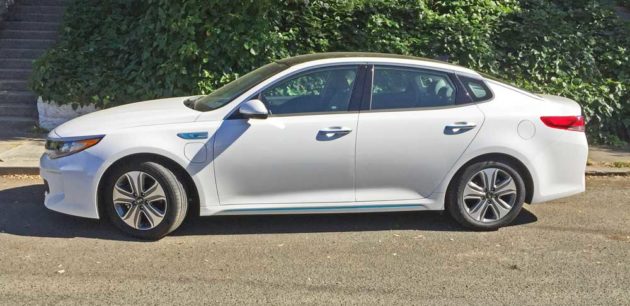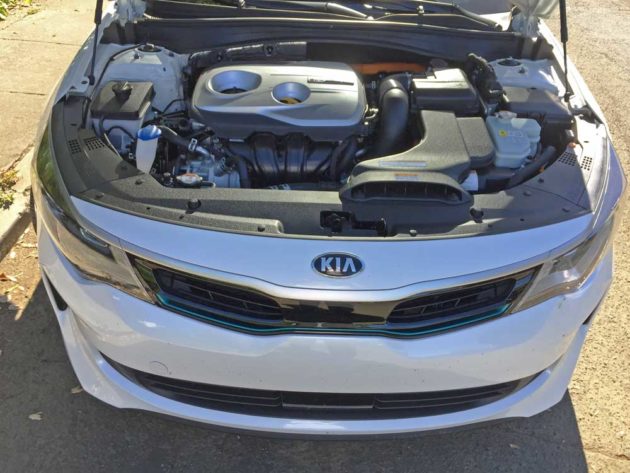?2017 Kia Optima PHEV EX ?
Optima stable offers three basic choices

Depending upon your environmental stance, Kia serves up a choice of three Optima sedans: the regular base Kia Optima; the Kia Optima Hybrid; and the Kia Optima PHEV or Plug-in Hybrid Electric Vehicle.

The Kia Optima PHEV is Kia?s first Plug-in hybrid and is being introduced as one of the vehicles included in Kia Motors EcoDynamics enviornmentally conscious sub-brand. The Optima PHEV bows with new technologies and features, including a more powerful hybrid engine, a more intelligent and substantial telematics system, exterior design enhancements, and greater interior refinement.

The Optima PHEV will only be available in EX trim and is built in Hwasung, South Korea. The all-new 2017 Optima PHEV was engineered with a dual focus on efficiency and driving dynamics. Utilizing Kia?s highly efficient 2.0-liter ?Nu? four-cylinder GDI (Gasoline Direct Injection) engine, mated to a six-speed automatic transmission, power output is targeted for a class-leading 154 hp @ 6,000 rpm. Electric power is produced by a transmission-mounted 50 kW motor, which is 42 percent more powerful than in the previous Optima Hybrid to allow for greater all-electric capability. This hybrid system provides a fast and seamless transition from EV to gasoline to hybrid modes, as well as more refined shift quality. Overall engine efficiency is also improved by the introduction of a High Voltage Electric Oil Pump, replacing the combination mechanical oil pump and low voltage electric pump found in the outgoing Optima Hybrid. Transmission cooling changes from natural air to water. These engineering enhancements yield an expected engine efficiency improvement of more than 20 percent.
With an estimated 600 miles of total driving range, the Optima PHEV?s next-generation battery system features a 9.8 kWh lithium-ion polymer battery pack, which produces roughly 60 percent more energy output than the battery pack found in the outgoing Optima?s hybrid system, and is estimated to achieve 27 miles in full EV mode, placing the Optima PHEV among the segment leaders in all-electric range.

To increase available cargo capacity in the trunk, the new battery pack is hidden behind the rear seat and tire well, giving Optima PHEV one of the largest cargo areas among all midsize PHEVs. Additional power to the battery system is generated from the vehicle?s improved Regenerative Braking System, which maximizes regenerative torque through refined cooperative control between the hybrid control unit and the brake actuation unit, resulting in a 10 percent increase in regenerative energy. The Optima PHEV is equipped with a single charging port conveniently located in the driver?s side front fender. A full charge can be achieved in less-than three hours via a 240V (Level 2) charger, and less-than nine hours via a 120V (Level 1) charger.

The all-new Optima PHEV provides its driver with options to reserve electric range via a plug-in hybrid mode select system. Exclusive to the PHEV variant of the all-new Optima, the system includes an all-Electric Mode (EV), which is suitable for short-range city driving, Hybrid Mode (HEV) for highway driving, and Charging Mode, which increases energy direction to the battery while driving at higher speeds. The energy produced while in Charging Mode can then be utilized in EV mode, extending the convenience of full electric power without stopping to charge.
An all-new Eco-DAS (Driver Assistance System) features Kia?s first application of Coasting Guide. This feature aims at maximizing fuel economy by essentially coaching the driver on when to coast and brake via an icon in the Instrument Panel that blinks for four-seconds and sounds a one-time audible alert.

My test Kia Optima PHEV came in the only trim available for it ? the EX. The base price was set at $35,210. But with the Snow White Pearl metallic paint and EX Technology Package along with the Inland Freight and Handling Charge bumping the final count an amount up to $41,750. prior to factoring in the receipt of any regional, state or federal tax credits.

Power is provided by a combination of: a 2.0-liter, DOHC, 16-valve, CVVT PHEV inline four-cylinder engine with Gasoline Direct Injection that produces 154 horsepower at 6,000 rpm and 140 pound feet of torque at 5,000 rpm; and an Interior-Permanent Magnet Synchronous Electric Motor that generates 66 (50kW) horsepower in a range from 2,300-3,300 rpm along with 151.2 pound feet of torque from 0-2,330 rpm. The motor?s energy comes from a Lithium-Ion polymer battery ? 270 VDC (nominal_ / Capacity is 27.2 Ah. – Voltage360V /Power Output 68 kW / Energy 9.8kWh. Combined system performance delivers 202 horsepower at 6,000 rpm and 276 pound feet of torque at 2,330 rpm. The hybrid system?s motive force is geared to the front wheels via an electronically controlled 6-speed automatic. The electric mode provides a rocket-like launch off the line, but is short lived when romped on. Blistering speed is not what the Optima PHEV is all about however ? its mission focus is efficient, affordable sustainable transportation. Electric mode (EV) is best suited to short range city jaunts, with the Hybrid Mode (HEV) ideal for highway driving, and the Charging Mode increases energy direction to the battery when driving at higher speeds. Charging Mode produced energy can be utilized in EV mode, which extends the convenience of full electric power without stopping to charge.

SUMMARY:?The Kia Optima PHEV is loaded with a host of intelligent technology, which not only enhances safety functions, but results in higher comfort levels. In fact, driving the Optima PHEV is not dramatically different from driving either the regular petrol or hybrid version in terms of the comfort level, handling characteristics and ride quality. The variances come in operational efficiency and convenience in replenishing the source of energy supply. The PHEV is heavier and thus when the battery?s energy is depleted, relegating the motive force to internal combustion becomes an issue that leans to the negative side of the ecology scale. Connectivity and safety technology features are shared with the rest of the Optima clan.

Passenger and cargo accommodations are adequate, and the PHEV is able to replenish the battery charge while on the move in a conventional hybrid manner, utilizing regenerative braking along with the engine, unlike some other plug-ins ? however, for a substantial restocking of the EV range, it would be necessary to be at idle or moving at crawl speed.

Driving scenarios would need to be heavily biased toward slow urban trips, covering short distances, to make the economy formula work. In the ranking of plug-in hybrids, the Optima PHEV is decent, but unless the price of gasoline increases significantly, the entire plug-in hybrid segment fails to justify itself as a major solution for the mass-market.

SPECIFICATIONS: 2017 Kia Optima PEHV EX
Base Price: $35,210.
Price as Tested: $41,750.
Engine Type and Size: 2.0-liter, DOHC, 16-valve, CVVT PHEV inline four-cylinder with Gasoline Direct Injection
Horsepower (bhp): 154 @ 6,000 rpm
Torque (ft./ lbs.): 140 @ 5,000 rpm
Electric Motor: Interior-Permanent Magnet Synchronous Motor
Horsepower: 66 (50kW) @ 2,300-3,300 rpm
Torque: 151.2 @ 0-2,330 rpm
Battery: Lithium-Ion polymer ? 270 VDC (Nominal) / Capacity ? 27.2 Ah. / Voltage360V /Power Output 68 kW / Energy 9.8kWh
System Performance Combined:
Horsepower: 202 @ 6,000 rpm
Torque: 276 @ 2,330 rpm
Transmission: Electronically controlled 6-speed automatic
Drive Train: Transversely mounted front engine / front-wheel drive
Suspension: Front – Independent MacPherson strut, coil springs and anti-roll bar.
Rear ? Independent multi-link coil springs and anti-roll bar.
Brakes: Active Hydraulic Boost System four-wheel discs (vented front), ESC and HAC.
Tires: Kumho Solus TA31 ? 215/55 R17 94V mounted on 5-?Sculpted-V? with machine face and painted inners.
Wheelbase: 110.43 inches
Length Overall: 191.10 inches
Width: 73.20 inches
Height: 57.50 inches
Curb Weight: 3,788 lbs.
Turning Circle: 35.76 ft.
Fuel Capacity: 13.42 gallons
EPA Mileage Estimates: 103 MPGe ? combined electricity and gasoline / 40 mpg ? gasoline only.
Drag Coefficient: 0.25
0 – 60 mph: Not tested
 Arv Voss is a Northern California based freelance motoring Journalist and member and past officer of several noted Automotive Journalist organizations who contributes regularly to a number of national and international media outlets. He reviews not only cars, trucks and SUVs, but motorcycles and unusual wheeled vehicles as well.
Arv Voss is a Northern California based freelance motoring Journalist and member and past officer of several noted Automotive Journalist organizations who contributes regularly to a number of national and international media outlets. He reviews not only cars, trucks and SUVs, but motorcycles and unusual wheeled vehicles as well.








